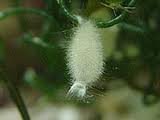Heres some background:
Probably the type of calcareous sponge most likely found in reef aquaria are the so-called "Pineapple" sponges. These small, white or gray sponges often appear in a reef aquarium a few weeks or months after it is set up, and may or may not persist for a long time. They tend to appear in areas of relatively high current flow, and big ones reach heights of an inch or so. Aquarists commonly say that they are in the genus Scypha. This may be true, but see the discussion and example in the next couple of paragraphs for the problem: calcareous sponges of essentially the same shape, size and color are described from different areas under the generic names of Scypha, Grantia, Sycon, Leucilla and Leucandra. Species from these species cannot be distinguished by cursory examination. Snap "off-the-wall" identification by aquarists is particularly problematic with the calcareous sponges, which tend to be smaller and more symmetrical than most other sponges.
The primary environmental condition that will determine the survival of any sponge is the water flow regime. To understand why water conditions are important, it is necessary to review how sponges gain nutrition. In general, sponges fill a volume with "tissue" and pump water through that volume to extract usable particulate food. A simple tubular or cylindrical sponge with its food collection area on the inner surface of a large cavity "wastes" a lot of internal space. Some of this is "dead" space caused by water currents, other space is wasted when water currents carry the suspended particulate material too far from the choanocytes. Consequently, most sponges' filtration area has been maximized by filling the cavity with - dare I say it? - a "spongy" mass of small chambers, each lined by choanocytes. Large sponges may have more than 10,000 chambers/mm3 (164 million chambers/cubic inch) containing, in total, many billions of choanocytes. Some of these large sponges have been calculated to pump their own weight of water through themselves about every five seconds. The larger ones likely can filter several thousand liters per day, removing up to 95% of bacteria and particulate organic material from the water. These sponges also differ from the "basic" sponge described in last month's article in that their body is often asymmetrical and without ostia; the visible pores on the outer surface are the openings of the water channel system (Reiswig, 1975; Ruppert, et al., 2003).
As a general rule, sponges feed primarily on very small particulate organic material of the size category containing bacterioplankton and the smallest phytoplankton. Larger phytoplankton also may be eaten, but this material is generally not collected by the choanocytes, but rather by the cell's surfaces around the small incurrent water passages. Many tropical sponges supplement their filter-feeding by having a symbiotic relationship with zooxanthellae. Regardless of this symbiosis, all sponges need to feed. They absorb dissolved organic material from the water, but also need to have a source of bacterial or nanoplankton. This source may be maintained in aquaria by having a good sand bed with sufficient infauna to cause some rapid turnover in bacterial productivity. Sponges will compete with other bacteriovores such as tunicates and, potentially, some SPS corals for this resource. Supplementation of the system with small, less than 5µm in diameter, phytoplankton cells may provide additional nutrition. Interestingly, a few sponges that are apparently wholly carnivorous in the family Cladorhizidae, catching prey by the action of hooked spicules on their body's surface, have recently been described from caves in the Mediterranean and deep seas elsewhere (Vaceletand Boury-Esnault 1995). These animals, not found in aquaria, eat small crustaceans.

